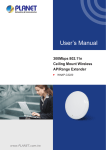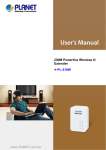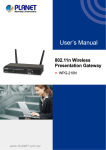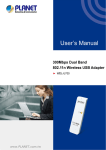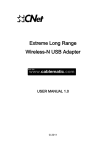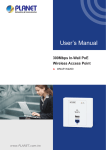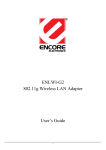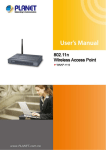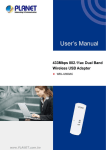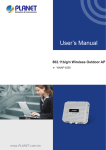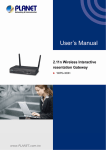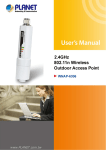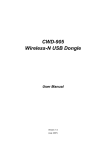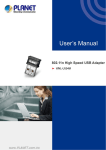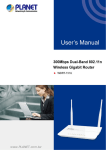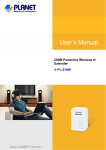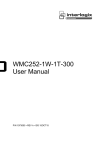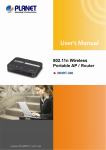Download User Manual - PLANET Technology Corporation.
Transcript
300Mbps 802.11n Wireless USB Adapter 300Mbps 802.11n Wireless USB Adapter WNL-U556M Copyright Copyright 2015 by PLANET Technology Corp. All rights reserved. No part of this publication may be reproduced, transmitted, transcribed, stored in a retrieval system, or translated into any language or computer language, in any form or by any means, electronic, mechanical, magnetic, optical, chemical, manual or otherwise, without the prior written permission of PLANET. PLANET makes no representations or warranties, either expressed or implied, with respect to the contents hereof and specifically disclaims any warranties, merchantability or fitness for any particular purpose. Any software described in this manual is sold or licensed "as is". Should the programs prove defective following their purchase, the buyer (and not PLANET, its distributor, or its dealer) assumes the entire cost of all necessary servicing, repair, and any incidental or consequential damages resulting from any defect in the software. Further, PLANET reserves the right to revise this publication and to make changes from time to time in the contents hereof without obligation to notify any person of such revision or changes. All brand and product names mentioned in this manual are trademarks and/or registered trademarks of their respective holders. Federal Communication Commission Interference Statement This equipment has been tested and found to comply with the limits for a Class B digital device, pursuant to Part 15 of FCC Rules. These limits are designed to provide reasonable protection against harmful interference in a residential installation. This equipment generates, uses, and can radiate radio frequency energy and, if not installed and used in accordance with the instructions, may cause harmful interference to radio communications. However, there is no guarantee that interference will not occur in a particular installation. If this equipment does cause harmful interference to radio or television reception, which can be determined by turning the equipment off and on, the user is encouraged to try to correct the interference by one or more of the following measures: 1. Reorient or relocate the receiving antenna. 2. Increase the separation between the equipment and receiver. 3. Connect the equipment to an outlet on a circuit different from that to which the receiver is connected. 4. Consult the dealer or an experienced radio technician for help. FCC Caution To assure continued compliance, use, for example, only shielded interface cables when connecting to computer or peripheral devices. Any changes or modifications not expressly approved by the party responsible for compliance could void the user’s authority to operate the equipment. This device complies with Part 15 of the FCC Rules. Operation is subject to the following two conditions: (1) This device may not cause harmful interference, and (2) this device must accept any interference received, including interference that may cause undesired operation. Federal Communication Commission (FCC) Radiation Exposure Statement This equipment complies with FCC radiation exposure set forth for an uncontrolled environment. In order to avoid the possibility of exceeding the FCC radio frequency exposure limits, human proximity to the antenna shall not be less than 20 cm (8 inches) during normal operation. -2- 300Mbps 802.11n Wireless USB Adapter WNL-U556M CE Mark Warning This is a class B device. In a domestic environment, this product may cause radio interference in which case the user may be required to take adequate measures. R&TTE Compliance Statement This equipment complies with all the requirements of DIRECTIVE 1999/5/CE OF THE EUROPEAN PARLIAMENT AND THE COUNCIL OF 9 March 1999 on radio equipment and telecommunication terminal equipment and the mutual recognition of their conformity (R&TTE). The R&TTE Directive repeals and replaces in the directive 98/13/EEC (Telecommunications Terminal Equipment and Satellite Earth Station Equipment) as of April 8, 2000. Safety This equipment is designed with the utmost care for the safety of those who install and use it. However, special attention must be paid to the dangers of electric shock and static electricity when working with electrical equipment. All guidelines of this and the computer manufacture must therefore be allowed at all times to ensure the safe use of the equipment. EU Countries Intended for Use The ETSI version of this device is intended for home and office use in Austria, Belgium, Denmark, Finland, France (with frequency channel restrictions), Germany, Greece, Ireland, Italy, Luxembourg, the Netherlands, Portugal, Spain, Sweden and United Kingdom. The ETSI version of this device is also authorized for use in EFTA member states: Iceland, Liechtenstein, Norway and Switzerland. WEEE Regulation To avoid the potential effects on the environment and human health as a result of the presence of hazardous substances in electrical and electronic equipment, end users of electrical and electronic equipment should understand the meaning of the crossed-out wheeled bin symbol. Do not dispose of WEEE as unsorted municipal waste; instead, collect them separately. Revision User’s Manual of PLANET 300Mbps 802.11n Micro-size Wireless USB Adapter Model: WNL-U556M Rev: EM-WNLU556M_v2.0 (May, 2015) Part No. 2081-E23190-001 -3- 300Mbps 802.11n Wireless USB Adapter WNL-U556M CONTENTS Chapter 1.PRODUCT INTRODUCTION ................................................................................................6 1.1 Package Contents .................................................................................................................6 1.2 Product Description ...............................................................................................................6 1.3 Product Features ...................................................................................................................9 1.4 Hardware Description ......................................................................................................... 10 Chapter 2.INSTALLATION ...................................................................................................................11 2.1 Microsoft Windows Driver Installation..................................................................................11 2.2 MAC OS X 10.x Driver Installation ..................................................................................... 17 2.3 Linux Driver Installation ...................................................................................................... 23 Chapter 3.CONNECTING TO WIRELESS NETWORK ...................................................................... 24 3.1 PLANET 11n USB Wireless LAN Utility.............................................................................. 24 3.2 Windows Zero Configuration .............................................................................................. 27 3.2.1 Windows XP - Use Windows Zero Configuration................................................... 28 3.2.2 Windows 7 - Use Windows 7 WLAN AutoConfig ................................................... 32 Chapter 4.PLANET USB WIRELESS LAN UTILITY.......................................................................... 35 4.1 4.2 Connection Profile Management ........................................................................................ 35 4.1.1 Add a new profile ................................................................................................... 36 4.1.2 Remove an existing profile..................................................................................... 38 4.1.3 Edit an existing profile ............................................................................................ 39 4.1.4 Make a copy of existing profile............................................................................... 41 4.1.5 Set as the default profile ........................................................................................ 41 General Information, Status, and Network Statistics .......................................................... 43 4.2.1 General Information ............................................................................................... 43 4.2.2 Status ..................................................................................................................... 43 4.2.3 Network Transmission Statistics ............................................................................ 44 4.3 Miscellaneous Settings....................................................................................................... 45 4.4 Wi-Fi Protected Setup (WPS)............................................................................................. 46 4.4.1 Push Button Config (PBC) ..................................................................................... 46 4.4.2 Pin Input Config (PIN) ............................................................................................ 48 Chapter 5.SOFT ACCESS POINT MODE .......................................................................................... 51 5.1 5.2 Switch between Access Point Mode and Station Mode ..................................................... 52 5.1.1 Configure SSID and Channel................................................................................. 54 5.1.2 Soft Access Point Security ..................................................................................... 55 Advanced Settings.............................................................................................................. 56 -4- 300Mbps 802.11n Wireless USB Adapter WNL-U556M 5.3 Wireless Transmission Statistics ........................................................................................ 57 5.4 Internet Connection Sharing (ICS) ..................................................................................... 58 Appendix: Specifications................................................................................................................... 60 Appendix: Troubleshooting............................................................................................................... 62 Appendix: Glossary............................................................................................................................ 63 Appendix: FAQ.................................................................................................................................... 68 -5- 300Mbps 802.11n Wireless USB Adapter WNL-U556M Chapter 1. PRODUCT INTRODUCTION 1.1 Package Contents The following items should be contained in the package: WNL-U556M (300Mbps Quick Installation Guide 802.11n Wireless CD (including driver, utility and user’s manual) Micro-size USB Adapter) If there is any item missing or damaged, please contact the seller immediately. 1.2 Product Description Ultra Mini-size Portable USB Adapter with 11n Performance PLANET WNL-U556M ultra mini-size portable USB adapter is specially designed for users who need high mobility and provides 300Mbps 802.11n high-speed wireless transmission. The ultra mini-size, compact design of the WNL-U556M is convenient to carry for all mobile users. The adapter does not need to be removed from a laptop anymore whether it is in use or at idle. It is just like a part of the laptop or PC and hidden very well once it is plugged into USB port. -6- 300Mbps 802.11n Wireless USB Adapter WNL-U556M High-speed 802.11n Wireless Experience The WNL-U556M offers a reliable and cost-effective wireless extension solution. It adopts IEEE 802.11n technology and is backward compatible with IEEE 802.11b and 802.11g. The WNL-U556M supports USB 2.0 interface that integrates with one transmit channel and one concurrent receive channel to enable both the data download and upload speeds to go up to 300Mbps. -7- 300Mbps 802.11n Wireless USB Adapter WNL-U556M Advanced Wireless Security The WNL-U556M provides advanced security features including 64/128-bit WEP, WPA / WPA2 and WPA-PSK / WPA2-PSK with TKIP/AES encryption. Furthermore, in order to simplify the security configurations, WPS (Wi-Fi Protected Setup) function is included to offer a convenient and fast connection method for users as well. Multiple OS Compliant The WNL-U556M supports the most popular operating systems including Windows XP, Vista, Win7, Win8, Linux, and MAC OS X. With high-speed capability, users can have higher wireless transmission speed anywhere, anytime. Software Access Point Function for Wireless Connection Sharing More than just being an adapter for PC and laptop connecting to a high-speed wireless network, the WNL-U556M can also become a wireless access point. By applying the USB Wireless LAN Utility included in the package, users can switch the WNL-U556M operation mode between Station mode and Access Point mode. When the WNL-U556M is in the Access Point mode, it turns to a Wi-Fi Hotspot. The Wi-Fi supported devices, such as iPhone, Android, Symbian, Windows Phone, iPod Touch, iPad, NDS and PSP, can connect to it and share the wireless access easily. Therefore, -8- 300Mbps 802.11n Wireless USB Adapter WNL-U556M travelers would then be worry-free as to connecting to Internet wirelessly via the WNL-U556M. Easy Installation Wizard The WNL-U556M provides an easy installation wizard in 35 languages. It guides users step by step to easily complete the product installation through the whole process. 1.3 Product Features 2.4GHz ISM band, unlicensed operation Compliant with IEEE 802.11b/g/n Provides download and upload data rates of up to 300Mbps Wi-Fi Protected Setup (WPS) support Supports WEP 64/128-bit, WPA / WPA2, WPA-PSK / WPA2-PSK (TKIP/AES encryption) Supports Software AP mode Supports Wireless QoS (WMM) Adjustable Transmit Power USB 2.0 attached interface Compact-size design Supports the most popular operating systems including Windows XP, Vista, Win 7, Win8, Linux, and MAC OS X. -9- 300Mbps 802.11n Wireless USB Adapter WNL-U556M 1.4 .4 Hardware Description Case Outlook LED Definition There is an LED equipped on the wireless adapter. When the data is transmitting, the LED will flash. LED Indicator LED Flashing Slowly Flashing Quickly Off Description The USB adapter has been installed but no data is being transmittered or received. Data transmitting or receiving The USB adapter has not been installed or the radio of the wireless USB adapter has been disabled from wireless utility. WPS (Wi-Fi Protected Setup) Button Press and hold the WPS button on the side of the adapter for 2 seconds to enable the WPS connection. WPS button -10- 300Mbps 802.11n Wireless USB Adapter WNL-U556M Chapter 2. INSTALLATION 2.1 Microsoft Windows Driver Installation Before installing the driver and utility of wireless adapter, do not insert the device into the USB port of your computer. 1. If you have ever installed other wireless adapters before, please uninstall the existing drivers and utilities first. 2. The following installation is performed in Windows XP. The procedures in other OS are similar. Please follow the instructions below to install the USB Wireless Adapter: Step 1. Insert the bundled CD into the CD-ROM drive. Step 2. Then a webpage will appear. Click the “Windows Utility (Driver)” hyperlink to initiate the installing wizard. -11- 300Mbps 802.11n Wireless USB Adapter WNL-U556M Step 3. Click the “Next” button to start installing the driver and utility. If the screen below appears during installation, please click the “Continue Anyway” button to continue. Step 4. After the software has been installed successfully, choose “Yes, I want to restart my computer now.” and click the “Finish” button to restart your computer. -12- 300Mbps 802.11n Wireless USB Adapter WNL-U556M Step 5. After restarting the computer, insert the wireless USB adapter into an empty USB port of your computer. Never force to insert the adapter if you feel it gets stuck. Flip the adapter over and try again. Then you’ll see the following message pop-up at the lower-right corner of the screen. -13- 300Mbps 802.11n Wireless USB Adapter WNL-U556M Step 6. The following window will pop up. Choose “No, not this time” and click the “Next” button to continue. Step 7. Choose “Install the software automatically (Recommended)”, and click the “Next” button to install the driver. -14- 300Mbps 802.11n Wireless USB Adapter WNL-U556M If the screen below appears during installation, please click the “Continue Anyway” button to continue. Step 8. Once the installation is finished, click the “Finish” button. After the driver of wireless adapter has been installed successfully, you’ll see another message pop-up at the lower-right corner of the screen. And there is also a new icon appeared on the system tray. -15- 300Mbps 802.11n Wireless USB Adapter WNL-U556M Left-clicking the new icon will launch PLANET 11n USB Wireless LAN Utility, and right-clicking the icon will show the quick menu of configuration utility. This icon also uses different colors to show the status of wireless connection: Wireless connection is established; good signal reception. Wireless connection is established; weak signal reception. Connection is not established yet. Wireless network card is not detected. -16- 300Mbps 802.11n Wireless USB Adapter WNL-U556M 2.2 MAC OS X 10.x Driver Installation The WNL-U556M supports MAC OS X 10.4 / 10.5 / 10.6 / 10.7. To install in MAC OS X operation system, please follow the instructions below to install the USB Wireless Adapter: Step 1. Unzip the driver package and then click the “Installer.pkg”. Step 2. It will pop up a window “Welcome to the Wireless USB Adapter Driver Installer”; please click “Continue”. Step 3. After reading the important information, please click “Continue” to continue. -17- 300Mbps 802.11n Wireless USB Adapter WNL-U556M Step 4. Select a language and click “Continue”. Step 5. Click “Agree” and then click “Continue”. -18- 300Mbps 802.11n Wireless USB Adapter WNL-U556M Step 6. Click “Install”. Step 7. Enter your Username and Password of the System. Then, click “OK”. 300Mbps 802.11n Wireless USB Adapter WNL-U556M Step 8. The window pops up the notice to remind you that computer will restart after finishing the installing. Please click “Continue Installation”. Step 9. Step 10. When the installation is successful, click “Restart”to restart your computer. After restarting the computer, plug the wireless adapter into the USB port on your computer. 300Mbps 802.11n Wireless USB Adapter WNL-U556M Step 11. Go to the administrator’s folder. Click “Applications”. Then, click “Wireless Network Utility”. Step 12. Click “Available Network”. Choose the AP you would like to connect to. Then, click “Add to Profile”. -21- 300Mbps 802.11n Wireless USB Adapter WNL-U556M Step 13. Select the encryption type of the AP that you want to connect to and fill in encryption key. Click “OK” to finish the installation and configuration of the wireless adapter! -22- 300Mbps 802.11n Wireless USB Adapter WNL-U556M 2.3 Linux Driver Installation The WNL-U556M supports the following Linux platforms: Linux Kernel 2.6.18~2.6.38 Linux Kernel 3.8.2 To install in Linux operating system, please refer to the README text file in the Linux_Driver folder included in the bundled CD. And also under the /Linux_Driver/document/ folder, the following documents are included: Quick_Start_Guide_for_Driver_Compilation_and_Installation.pdf Quick_Start_Guide_for_Station_Mode.pdf wpa_cli_with_wpa_supplicant.pdf HowTo_support_more_VidPids.pdf Wireless_tools_porting_guide.pdf HowTo_enable_driver_to_support_WIFI_certification_test.pdf HowTo_enable_the_power_saving_functionality.pdf Quick_Start_Guide_for_SoftAP.pdf SoftAP_Mode_features.pdf linux_dhcp_server_notes.txt Quick_Start_Guide_for_Bridge.pdf RTK_Wi-Fi_Direct_Programming_guide.pdf Obtain the Linux driver source code from the bundled CD, and build the driver for the Linux OS that you are using. -23- 300Mbps 802.11n Wireless USB Adapter WNL-U556M Chapter 3. CONNECTING TO WIRELESS NETWORK To use wireless network, you have to connect to a wireless access point first. You can either use PLANET 11n USB Wireless LAN Utility (comes with network adapter), or Windows Zero Config utility (comes with Windows operating system). 3.1 PLANET 11n USB Wireless LAN Utility Please follow the instructions below to connect the wireless access point via PLANET 11n USB Wireless LAN Utility. Step 1. Left-click the PLANET Wireless Utility icon located at the lower-right corner of the screen and configuration menu will appear: Step 2. Click the “Available Network” label. Please wait for a while, and all wireless access points nearby which can be reached by the wireless adapter will be displayed here. If the wireless access point you wish to connect to does not appear here, you can click the “Refresh” button to scan for wireless access points again; if the wireless access point you’re looking for still does not appear, try to move the computer closer to the access point. -24- 300Mbps 802.11n Wireless USB Adapter WNL-U556M Step 3. When the access point you’re looking for is on the list, left-click it and then double-click it or click “Add to Profile”. Step 4. If a password (Network Key) is required to access the wireless access point, please input it in the “Network key” field, and input it again in the ”Confirm network key” field for confirmation. Click “OK” after the password is already properly inputted. Network security option (“Network Authentication” and “Data encryption”) will be selected automatically based on the security setting of the wireless access point you selected. It’s not necessary to change these settings by your own self. All options on this page will be filled automatically according to the access point you wish to add to profile. However, you can still modify any of them to meet your requirements. Object Description Profile Name You can give a name to this profile, so you can remember its purpose easily. It can be any phrase to help you remember. Network Name (SSID) The SSID (Service Set IDentifier, i.e. access point’s name). This field will be filled as the access point you selected when -25- 300Mbps 802.11n Wireless USB Adapter WNL-U556M SSID is not hidden and grayed out. If SSID is hidden, you have to input the correct SSID yourself. Computer-to-computer (ad-hoc) Network Check this box if you wish to connect to another computer / network device by the ad-hoc method. When not accessing to wireless access point, you have to check this box. Channel Select wireless channel for the ad-hoc connection. This option only appears when you’re using the ad-hoc connection. Network Authentication Select the network authentication type from the drop-down menu. This setting must be identical with the setting of wireless access point you wish to connect to. Data Encryption Select the data encryption type from the drop-down menu. This setting must be identical with the setting of wireless access point you wish to connect to. ASCII / PASSPHRASE When the encryption type is “WEP”, it’s required to input a set of “passphrases” to connect to wireless access point. Checking “ASCII” or “PASSPHRASE” depends on the security setting of access point, and input it in the box; if you select “PASSPHRASE”, you also need to select the length of the key. The passphrase must be identical with the setting of wireless access point you wish to connect to. Key Index Select WEP key index. For most of access points you can select “1”, but please refer to the setting of the access point. Network Key / Confirm Network Key When the encryption type is “WPA” or “WPA2-PSK”, it’s required to input a set of “passphrases” to connect to wireless access point. Please input the same passphrase in two boxes for confirmation. EAP Type / Tunnel / Provision Mode When the authentication type is any of 802.1X, you have to select the EAP type, tunnel, and provision mode from the dropdown menu. This setting must be identical with your 802.1x authentication server. Username / Identity / Please input 802.1x related authentication information here. Domain / Password Certificate If certification is required to authenticate with 802.1x authentication server, please select a local certificate from the dropdown list. PAC Check this box and PAC (Privilege Access Certificate) will be automatically selected. Please click “OK” when ready. Step 5. Wireless adapter will attempt to connect to access point; this may require a few seconds to minutes. When the “Status” become “Associated”, your computer is connected to access point you selected. Click “Close” to close configuration window. -26- 300Mbps 802.11n Wireless USB Adapter WNL-U556M If you are connected to an access point but the connection is out, please check security settings and re-check password spelling. 3.2 Windows Zero Configuration Windows XP, Vista, 7 and 8 have a built-in wireless network configuration utility called as “Windows Zero Configuration” (WZC). You can also use WZC to configure your wireless network parameter: Step 1. Right-click PLANET Wireless Utility icon and click “Open Config Utility”. -27- 300Mbps 802.11n Wireless USB Adapter WNL-U556M Step 2. Check the “Windows Zero Config” box. Step 3. A dialog appears indicating that you’ve been already switched to Windows Zero Config mode. To return to use PLANET wireless utility, uncheck the “Windows Zero Config” box. 3.2.1 Windows XP - Use Windows Zero Configuration Step 4. Click the “Start” button (should be located at the bottom-left corner of Windows desktop), click “Control Panel” and then click “Network and Internet Connections” in Control Panel. -28- 300Mbps 802.11n Wireless USB Adapter WNL-U556M Step 5. Double-click “Network and Internet Connections”. -29- 300Mbps 802.11n Wireless USB Adapter WNL-U556M Step 6. Right-click “Wireless Network Connection” (It may have a number as suffix if you have more than one wireless network adapter. Please make sure you right-click the PLANET Wireless LAN 802.11n USB Network Adapter) and then select “View Available Wireless Networks”. Step 7. All wireless access points in proximity will be displayed here. If the access point you want to use is not displayed here, please try to move your computer closer to the access point, or you can click “Refresh network list” to rescan access points. Click the access point you want to use if it’s shown and then click “Connect”. -30- 300Mbps 802.11n Wireless USB Adapter WNL-U556M Step 8. If the access point is protected by encryption, you have to input its network key or passphrase here. It must match the encryption setting on the access point. If the access point you selected does not use encryption, you’ll not be prompted for network key or passphrase. Step 9. If you can see “Connected” message, the connection between your computer and wireless access point you selected is successfully established. -31- 300Mbps 802.11n Wireless USB Adapter WNL-U556M 3.2.2 Windows 7 - Use Windows 7 WLAN AutoConfig WLAN AutoConfig service is built-in in Windows 7 that can be used to detect and connect to wireless network. This built-in wireless network connection tool is similar to wireless zero configuration tool in Windows XP. Step 1: Right-click on the network icon displayed in the system tray Step 2: Highlight and select the wireless network (SSID) to connect. (1) All wireless access points in proximity will be displayed here. If the access point you want to use is not displayed here, please try to move your computer closer to the access point, or you can click “Refresh network list” to rescan access points. (2) Click the access point you want to use if it’s shown and then click “Connect”. -32- 300Mbps 802.11n Wireless USB Adapter WNL-U556M If you will be connecting to this Wireless Router in the future, check [Connect automatically]. Step 4: Enter the network security key of the wireless access point. (1) The Connect to a Network box will appear (2) Enter the security key If the access point is protected by encryption, you have to input its network key or passphrase here. It must match the encryption setting on the access point. (3) Click the [OK] button -33- 300Mbps 802.11n Wireless USB Adapter WNL-U556M Step 5: Check if “Connected” is displayed 300Mbps 802.11n Wireless USB Adapter WNL-U556M Chapter 4. PLANET USB WIRELESS LAN UTILITY 4.1 Connection Profile Management If you need to connect to different wireless access points at different times, like access point at home, office, cyber-cafe, or public wireless service, you can save the connection parameters (encryption, passphrase, security, etc.) as profiles for every access point, so you don’t have to input these parameters every time when you want to connect to the specific wireless access point. To manage profiles, right-click the PLANET wireless utility icon located at the lower-right corner of the screen and then click “Open Config Utility”. Click the “Profile” label. -35- 300Mbps 802.11n Wireless USB Adapter WNL-U556M 4.1.1 Add a new profile You can set up the connection parameters for the specific wireless access point in advance. If you want to create a new profile, click the “Add” button. You’ll be prompted to input connection parameters for the wireless access point you wish to connect to: -36- 300Mbps 802.11n Wireless USB Adapter WNL-U556M Required parameters are as follows: Object Description Profile Name You can give a name to this profile, so you can remember its purpose easily. It can be any phrase to help you remember. Network Name (SSID) The SSID (Service Set IDentifier, i.e. access point’s name). This field will be filled as the access point you selected when SSID is not hidden and grayed out. If SSID is hidden, you have to input the correct SSID yourself. Computer-to-computer (ad-hoc) Network Check this box if you wish to connect to another computer / network device by the ad-hoc method. When not accessing to wireless access point, you have to check this box. Channel Select wireless channel for the ad hoc connection. This option only appears when you’re using the ad-hoc connection. Network Authentication Select the network authentication type from the drop-down menu. This setting must be identical with the setting of wireless access point you wish to connect to. Data Encryption Select the data encryption type from the drop-down menu. This setting must be identical with the setting of wireless access point you wish to connect to. ASCII / PASSPHRASE When the encryption type is “WEP”, it’s required to input a set of “passphrases” to connect to wireless access point. Checking “ASCII” or “PASSPHRASE” depends on the security -37- 300Mbps 802.11n Wireless USB Adapter WNL-U556M setting of access point, and input it in the box; if you select “PASSPHRASE”, you also need to select the length of the key. The passphrase must be identical with the setting of wireless access point you wish to connect to. Key Index Select WEP key index. For most of access points you can select “1”, but please refer to the setting of the access point. Network Key / Confirm Network Key When the encryption type is “WPA” or “WPA2-PSK”, it’s required to input a set of “passphrases” to connect to wireless access point. Please input the same passphrase in the two boxes for confirmation. EAP Type / Tunnel / Provision Mode When the authentication type is any of 802.1X, you have to select the EAP type, tunnel, and provision mode from the dropdown menu. This setting must be identical with your 802.1x authentication server. Username / Identity / Please input 802.1x related authentication information here. Domain / Password Certificate If certification is required to authenticate with 802.1x authentication server, please select a local certificate from the dropdown list. PAC Check this box and PAC (Privilege Access Certificate) will be automatically selected. When all the required parameters are set, click “OK” to create and save a new profile. 4.1.2 Remove an existing profile If you want to remove a profile no longer needed, click the “Profile” label and then select the existing profile you wish to remove, and click the “Remove” button. -38- 300Mbps 802.11n Wireless USB Adapter WNL-U556M 4.1.3 Edit an existing profile If you have added a profile before, and now you wish to change the settings of the profile, you can use this function. Please select the profile from the list first and then click the “Edit” button. The contents of the selected profile will appear. After editing them, you can click “OK” to save changes, or click “Cancel” to discard changes. -39- 300Mbps 802.11n Wireless USB Adapter WNL-U556M -40- 300Mbps 802.11n Wireless USB Adapter WNL-U556M 4.1.4 Make a copy of existing profile If you need to create a new profile whose parameters are similar to any existing profile, you can make a copy of a specific profile and edit the copy to save as a new profile. To do this, select an existing profile and then click the “Duplicate” button. You’ll be prompted to input a new profile name. Please use an identical name that does not exist in the profile list. 4.1.5 Set as the default profile If you wish to use a specific profile as the default wireless connection, you can select the profile in the list, and click “Set Default”. The selected profile will become default selection and PLANET wireless utility will attempt to connect to the selected access point. -41- 300Mbps 802.11n Wireless USB Adapter WNL-U556M -42- 300Mbps 802.11n Wireless USB Adapter WNL-U556M 4.2 General Information, Status, and Network Statistics PLANET wireless utility provides the detailed information about the wireless connection you’re using. 4.2.1 General Information If you want to know the general information of the access point you’re connecting to, click the “General” label: All general information like signal strength and link quality will be displayed here. The information is very useful when you encounter some problems in connecting to access point. If you wish to get a new IP address from DHCP server, you can click the “ReNew IP” button. 4.2.2 Status If you want to know the status of your wireless network card, click the “Status” label: -43- 300Mbps 802.11n Wireless USB Adapter WNL-U556M 4.2.3 Network Transmission Statistics To view the statistical data of wireless adapter, click the “Statistics” label, and the statistics of wireless connection will be displayed: All connection-related statistics are displayed here. You can click the “Reset” button to reset the statistics of all items back to 0. -44- 300Mbps 802.11n Wireless USB Adapter WNL-U556M 4.3 Miscellaneous Settings There are some other functions provided by PLANET wireless utility, and you can access these functions from the bottom of configuration window: The descriptions of the function are listed as follows: Object Description Show Tray Icon Check this box to show an icon on system tray. Uncheck this box to hide it. Radio Off Switch wireless radio off. Wireless network functionalities are disabled. Disable Adapter Disable wireless adapter. All functionalities of configuration menu will disappear. To resume, uncheck “Disable Adapter”. Windows Zero Use Windows Zero Configuration to manage wireless connections. Config See Chapter 3.2. -45- 300Mbps 802.11n Wireless USB Adapter WNL-U556M 4.4 Wi-Fi Protected Setup (WPS) Wi-Fi Protected Setup (WPS) is the latest wireless network technology which makes setting up wireless network more quickly and easily. If you have WPS-supported wireless access point, and you want to establish a secure connection to it, you don’t have to configure the wireless access point and set up data encryption by your ownself. PLANET Wireless LAN Utility supports two WPS methods: “Pin Input Config (PIN)” and “Push Button Config (PBC)”. Please follow the instructions below to establish the secure connection between WPS-supported wireless access point and PLANET wireless adapter. Step 1. Right-click PLANET wireless utility icon and click “Open Config Utility”. Step 2. Click the “Wi-Fi Protect Setup” label. Step 3. You can choose which WPS method to use: Pin Input Config (PIN) or Push Button Config (PBC), and WPS-supported wireless access point must use the same method. See the next two chapters for detailed instructions of each WPS method. 4.4.1 Push Button Config (PBC) This is the easiest way to establish secure connection by WPS, but if there’re more than one WPS-supported access point using Push-Button config, please use Pin Input Config (PIN) instead. -46- 300Mbps 802.11n Wireless USB Adapter WNL-U556M Step 4. Please click the “Push Button Config (PBC)” button. Then a message window will appear: Step 5. After tabbing the Push Button Config button, press the physical button on your wireless access point or virtual button on the WPS configuration page. -47- 300Mbps 802.11n Wireless USB Adapter WNL-U556M Step 6. After activating the WPS function of wireless access point, the secure connection between wireless adapter and the WPS-supported access point will be established automatically. 4.4.2 Pin Input Config (PIN) Step 4. Please click the “Pin Input Config (PIN)” button: You’ll be prompted to select an access point you wish to connect to. If you know its SSID, click “Yes”, otherwise click “No”. -48- 300Mbps 802.11n Wireless USB Adapter WNL-U556M Step 5. If you select “Yes”, a list of all WPS-supported APs nearby will be displayed. You can click the “Refresh” button to rescan. Click an access point you want to connect to and click the “Select” button. If you select “No”, wireless adapter will prompt you to enter an 8-digit pin code into your access point, without selecting an access point in advance. Step 6. After you select “Yes” or “No” in the previous step, wireless adapter will attempt to connect to WPS-supported access point, and an 8-digit number will appear. -49- 300Mbps 802.11n Wireless USB Adapter WNL-U556M Step 7. Please input this number into the configuration of the access point within 2 minutes, and the secure connection between wireless adapter and the WPS-supported access point will be established automatically. To stop this procedure before connection is established, click the “Cancel” button. -50- 300Mbps 802.11n Wireless USB Adapter WNL-U556M Chapter 5. SOFT ACCESS POINT MODE Besides being a wireless client of other wireless access points, PLANET wireless adapter can also act as a wireless service provider. You can switch the operation mode of wireless adapter to “Access Point” mode to simulate the function of a real wireless access point by software. And all other computers and Wi-Fi supported devices can connect to your computer wirelessly, even share your internet connection service. Application: Software AP Mode with xDSL/Cable Internet Connection Application: Software AP Mode with 3G/LTE Internet Connection -51- 300Mbps 802.11n Wireless USB Adapter WNL-U556M 5.1 Switch between Access Point Mode and Station Mode The default operation mode of the wireless adapter is “Station Mode” (being a client of other wireless access points). Please follow the instructions below to switch to Access Point mode: Step 1. Right-click PLANET wireless utility icon and click “Open Config Utility”. Step 2. Select “Mode(M)” and then click “Access Point”. It requires a few seconds to switch mode. -52- 300Mbps 802.11n Wireless USB Adapter WNL-U556M After the mode switch is complete, the window of general information about software access point will appear, including SSID, IP address of the Soft AP and connected wireless clients. Also the wireless LAN Utility icon in you system tray (lower-right corner) can be changed to another icon. Station mode icon: Access Point icon: -53- 300Mbps 802.11n Wireless USB Adapter WNL-U556M 5.1.1 Configure SSID and Channel To configure software Access Point, click the “Config” button, and the “Wireless Network Properties” will be displayed. Please note that the Ad-Hoc mode is not available when the wireless adapter is in the Access Point mode. The setup options are listed below: Object Description Network Name Please input the SSID (the name used to identify this wireless (SSID) access point) here. Up to 32 numerical characters can be accepted here, excluding space. Channel Please select the wireless channel you wish to use, from 1 to 13. To save changes, click “OK”; otherwise, click “Cancel” to discard changes. -54- 300Mbps 802.11n Wireless USB Adapter WNL-U556M 5.1.2 Soft Access Point Security To set up security options for Soft Access Point, configure “Wireless Network Security” as follows: The setup items about wireless security are listed below: Object Description Network Authentication Select the network authentication mode from the dropdown menu. Data Encryption Select the data encryption method from the dropdown menu. ASCII / PASSPHRASE Key Index If the encryption method is WEP, check either “ASCII” or “PASSPHRASE” box and input it in the box as WEP passphrase. Select WEP key index (1-4). If you don’t know which one you should use, select 1. Network Key / Confirm If the network authentication mode is WPA, please input WPA Network Key passphrase in both boxes. To save changes, click “OK”; otherwise, click “Cancel” to discard changes. -55- 300Mbps 802.11n Wireless USB Adapter WNL-U556M 5.2 Advanced Settings Click the “Advanced” label to set up advanced settings of software access point. If you don’t know the meaning and affects of these settings, please keep them as default. The setup items are listed below: Object Description Beacon Interval Please input wireless beacon time interval here. DTIM Period Please input DTIM (Delivery Traffic Indication Message) here. Preamble Mode Select wireless frame preamble mode (long or short) from the dropdown menu. Set Defaults Reset all the settings back to the factory default value. Apply Save changes. If you change any setting here and cause some problem on communicating with wireless clients, click “Set Defaults” to reset all the settings back to the default settings. -56- 300Mbps 802.11n Wireless USB Adapter WNL-U556M 5.3 Wireless Transmission Statistics Click the “Statistics” label and the data statistics about software access point will be displayed. Click the “Reset” button to reset the value of every item back to “0”. -57- 300Mbps 802.11n Wireless USB Adapter WNL-U556M 5.4 Internet Connection Sharing (ICS) You can assign a network adapter on your computer as the path for all wireless clients to get connected to Internet. If you have only one network adapter (besides the software access point), you don’t have to select the network adapter here. Click the “Apply” button to save changes (The “Apply” button is grayed out when no changes are made in this label.). -58- 300Mbps 802.11n Wireless USB Adapter WNL-U556M If you have more than one network adapter, select the one you wish to be used as Internet gateway. For example, the 3G USB dongle is connected to the laptop for internet access. The other portable wireless devices can enjoy the internet surfing through the software AP and 3G connection sharing. -59- 300Mbps 802.11n Wireless USB Adapter WNL-U556M Appendix: Specifications Product 300Mbps 802.11n Wireless Micro-size USB Adapter Model WNL-U556M Hardware Specifications Interface USB 2.0, Type-A Antenna Type Internal Omni-directional PIFA Antenna Antenna Gain 2dBi Button WPS Push Button (PBC mode) to launch WPS connection LED 1 x Link / Active (Green) Operating Voltage 5V DC, power input from USB port Dimensions 29 x 14.4 x 6mm Wireless Specifications Standards IEEE 802.11n standard compliant Conformance IEEE 802.11b/g backward compatible RF Modulation DBPSK,DQPSK,CCK, OFDM Frequency Band 2.4-2.4835 GHz Opt. Channel America/ FCC: 2.414~2.462GHz (11 Channels) Europe/ ETSI: 2.412~2.472GHz (13 Channels) Japan/ TELEC: 2.412~2.484GHz (14 Channels) 802.11b: 11, 5.5, 2 and 1 Mbps with auto-rate fall back Data Rate 802.11g: 54, 48, 36, 24, 18, 12, 9 and 6Mbps 802.11n (20MHz): up to 144.4Mbps 802.11n (40MHz): up to 300Mbp Wireless Transmit Power (EIRP) 802.11b: 18 ± 1dBm 802.11g: 15 ± 1dBm 802.11n: 13 ± 1dBm IEEE 802.11b: -85dBm Receiver Sensitivity IEEE 802.11g: -70dBm IEEE 802.11n: -68dBm Operation Mode Ad-Hoc / Infrastructure, Soft AP WEP 64/128-bit Encryption Security WPA / WPA2 (TKIP/AES) WPA-PSK / WPA2-PSK (TKIP/AES) Wireless Advanced Management Supports 802.11e WMM (Wi-Fi Multimedia) Supports Software/Hardware WPS (Wi-Fi Protected Setup) The utility included in the package or Windows XP Zero Configuration utility -60- 300Mbps 802.11n Wireless USB Adapter WNL-U556M Windows XP (x86/x64) / VISTA (x86/x64) / Win7 (x86/x64) / Win8 Operating Systems (x86/x64) Linux Kernel 2.6/3.8.2 Macintosh 10.4 to 10.8 Effective Distance 12 meters Certification Emission CE, FCC Environment Operating Temperature 0°C~40°C (32°F~104°F) Humidity 10% ~ 90%, non condensing WNL-U556M (300Mbps 802.11n Wireless Micro-size USB adapter) Package Contents Quick Installation Guide CD (including driver, utility and user’s manual) -61- 300Mbps 802.11n Wireless USB Adapter WNL-U556M Appendix: Troubleshooting Symptom : Remedy : Symptom : Remedy : Symptom : Remedy : Symptom : The LED is off. Make sure the PC Card is inserted properly. Otherwise, contact your vendor. The LED is always on, not blinking. Make sure that you have installed the driver from the attached CD. Otherwise contact your vendor. The LED is blinking but the PC Card icon does not appear in your icon tray. Make sure that you have installed the Utility from the attached CD. The PC Card is linking, but can’t share files with others. Make sure the file and printer sharing function is enabled. Remedy : Symptom : Remedy : You can enable the function by checking the icon of My Computer -> Control Panel -> Network -> file and printer sharing -> I want to be able to give others to access my files. Slow or poor performance in AP mode Try to select another channel for the communicating group or move your device closer to the Access Point. -62- 300Mbps 802.11n Wireless USB Adapter WNL-U556M Appendix: Glossary 1. IEEE 802.11 Standard The IEEE 802.11 Wireless LAN standards subcommittee, which is formulating a standard for the industry. 2. Access Point An internetworking device that seamlessly connects wired and wireless networks together. 3. Ad Hoc An Ad Hoc wireless LAN is a group of computers, each with a WLAN adapter, connected as an independent wireless LAN Ad Hoc wireless LAN is applicable at a departmental scale for a branch or SOHO operation. 4. BSSID A specific Ad Hoc LAN is called a Basic Service Set (BSS). Computers in a BSS must be configured with the same BSSID. 5. DHCP Dynamic Host Configuration Protocol - a method in which IP addresses are assigned by server dynamically to clients on the network. DHCP is used for Dynamic IP Addressing and requires a dedicated DHCP server on the network. 6. Direct Sequence Spread Spectrum This is the method the wireless cards use to transmit data over the frequency spectrum. The other method is frequency hopping. Direct sequence spreads the data over one frequency range (channel) while frequency hopping jumps from one narrow frequency band to another many times per second. 7. ESSID An Infrastructure configuration could also support roaming capability for mobile workers. More than one BSS can be configured as an Extended Service Set (ESS). Users within an ESS could roam freely between BSSs while served as a continuous connection to the network wireless stations and Access Points within an ESS must be configured with the same ESSID and the same radio channel. 8. Ethernet Ethernet is a 10/100Mbps network that runs over dedicated home/office wiring. Users must be wired to the network at all times to gain access. 9. Gateway A gateway is a hardware and software device that connects two dissimilar systems, such as a LAN and a mainframe. In Internet terminology, a gateway is another name for a router. Generally a gateway is used as a funnel for all traffic to the Internet -63- 300Mbps 802.11n Wireless USB Adapter WNL-U556M 10. IEEE Institute of Electrical and Electronics Engineers Infrastructure. An integrated wireless and wired LAN is called an Infrastructure configuration. Infrastructure is applicable to enterprise scale for wireless access to central database, or wireless 11. ISM Band The FCC and their counterparts outside of the U.S. have set aside bandwidth for unlicensed use in the so-called ISM (Industrial, Scientific and Medical) band. Spectrum in the vicinity of 2.4 GHz, in particular, is being made available (Industrial, Scientific and Medical) band. Spectrum in the vicinity of 2.4 GHz, in particular, is being made available of users around the globe. 12. Local Area Network (LAN) A LAN is a group of computers, each equipped with the appropriate network adapter card connected by cable/air, that share applications, data, and peripherals. All connections are made via cable or wireless media, but a LAN does not use telephone services. It typically spans a single building or campus. 13. Network A network is a system of computers that is connected. Data, files, and messages can be transmitted over this network. Networks may be local or wide area networks. 14. Protocol A protocol is a standardized set of rules that specify how a conversation is to take place, including the format, timing, sequencing and/ or error checking. 15. SSID A Network ID unique to a network. Only clients and Access Points that share the same SSID are able to communicate with each other. This string is case-sensitive. 16. Static IP Addressing A method of assigning IP addresses to clients on the network. In networks with Static IP address, the network administrator manually assigns an IP address to each computer. Once a Static IP address is assigned, a computer uses the same IP address every time it reboots and logs on to the network, unless it is manually changed. 17. Temporal Key Integrity Protocol (TKIP) The Temporal Key Integrity Protocol, pronounced tee-kip, is part of the IEEE 802.11i encryption standard for wireless LANs. TKIP is the next generation of WEP, the Wired Equivalency Protocol, which is used to secure 802.11 wireless LANs. TKIP provides per-packet key mixing, a message integrity check and a re-keying mechanism, thus fixing the flaws of WEP. 18. Transmission Control Protocol / Internet Protocol (TCP/IP) TCP/IP is the protocol suite developed by the Advanced Research Projects Agency (ARPA). It is widely used in corporate Internet works, because of its superior design for WANs. TCP governs how packet is sequenced for transmission the network. The term “TCP/IP” is often used generically to refer to the entire suite of related protocols. 300Mbps 802.11n Wireless USB Adapter WNL-U556M 19. Transmit / Receive The wireless throughput in Bytes per second averaged over two seconds. 20. Wi-Fi Alliance The Wi-Fi Alliance is a nonprofit international association formed in 1999 to certify interoperability of wireless Local Area Network products based on IEEE 802.11 specification. The goal of the Wi-Fi Alliance’s members is to enhance the user experience through product interoperability. The organization is formerly known as WECA. 21. Wi-Fi Protected Access (WPA) The Wi-Fi Alliance put together WPA as a data encryption method for 802.11 wireless LANs. WPA is an industry-supported, pre-standard version of 802.11i utilizing the Temporal Key Integrity Protocol (TKIP), which fixes the problems of WEP, including using dynamic keys. 22. Wide Area Network (WAN) A WAN consists of multiple LANs that are tied together via telephone services and / or fiber optic cabling. WANs may span a city, a state, a country, or even the world 23. Wired Equivalent Privacy (WEP) Now widely recognized as flawed, WEP was a data encryption method used to protect the transmission between 802.11 wireless clients and APs. However, it used the same key among all communicating devices. WEP’s problems are well-known, including an insufficient key length and no automated method for distributing the keys. WEP can be easily cracked in a couple of hours with off-the-shelf tools. 24. Wireless LAN (WLAN) A wireless LAN does not use cable to transmit signals, but rather uses radio or infrared to transmit packets through the air. Radio Frequency (RF) and infrared are the commonly used types of wireless transmission. Most wireless LANs use spread spectrum technology. It offers limited bandwidth, usually under 11Mbps, and users share the bandwidth with other devices in the spectrum; however, users can operate a spread spectrum device without licensing from the Federal Communications Commission (FCC). 25. Fragment Threshold The proposed protocol uses the frame fragmentation mechanism defined in IEEE 802.11 to achieve parallel transmissions. A large data frame is fragmented into several fragments each of size equal to fragment threshold. By tuning the fragment threshold value, we can get varying fragment sizes. The determination of an efficient fragment threshold is an important issue in this scheme. If the fragment threshold is small, the overlap part of the master and parallel transmissions is large. This means the spatial reuse ratio of parallel transmissions is high. In contrast, with a large fragment threshold, the overlap is small and the spatial reuse ratio is low. However high fragment threshold leads to low fragment overhead. Hence there is a trade-off between spatial re-use and fragment overhead. Fragment threshold is the maximum packet size used for fragmentation. Packets larger than the size programmed in this field will be fragmented If you find that your corrupted packets or asymmetric packet reception (all send packets, for example). You may want to try lowering your fragmentation threshold. This will cause packets to be broken into smaller fragments. These small fragments, if corrupted, can be resent faster than a larger fragment. Fragmentation increases 300Mbps 802.11n Wireless USB Adapter WNL-U556M overhead, so you'll want to keep this value as close to the maximum value as possible. 26. RTS (Request To Send) Threshold The RTS threshold is the packet size at which packet transmission is governed by the RTS/CTS transaction. The IEEE802.11-1997 standard allows for short packets to be transmitted without RTS/CTS transactions. Each station can have a different RTS threshold. RTS/CTS is used when the data packet size exceeds the defined RTS threshold. With the CSMA/CA transmission mechanism, the transmitting station sends out an RTS packet to the receiving station, and waits for the receiving station to send back a CTS (Clear to Send) packet before sending the actual packet data. This setting is useful for networks with many clients. With many clients, and a high network load, there will be many more collisions. By lowering the RTS threshold, there may be fewer collisions, and performance should improve. Basically, with a faster RTS threshold, the system can recover from problems faster. RTS packets consume valuable bandwidth, however, so setting this value too low will limit performance. 27. Beacon Interval In addition to data frames that carry information from higher layers, 802.11 includes management and control frames that support data transfer. The beacon frame, which is a type of management frame, provides the "heartbeat" of a wireless LAN, enabling stations to establish and maintain communications in an orderly fashion. Beacon Interval represents the amount of time between beacon transmissions. Before a station enters power save mode, the station needs the beacon interval to know when to wake up to receive the beacon (and learn whether there are buffered frames at the access point). 28. Preamble Type There are two preamble types defined in IEEE 802.11 specification. A long preamble basically gives the decoder more time to process the preamble. All 802.11 devices support a long preamble. The short preamble is designed to improve efficiency (for example, for VoIP systems). The difference between the two is in the Synchronization field. The long preamble is 128 bits, and the short is 56 bits. 29. WPA2 It is the second generation of WPA. WPA2 is based on the final IEEE 802.11i amendment to the 802.11 standard. 30. Temporal Key Integrity Protocol (TKIP) The Temporal Key Integrity Protocol, pronounced tee-kip, is part of the IEEE 802.11i encryption standard for wireless LANs. TKIP is the next generation of WEP, the Wired Equivalency Protocol, which is used to secure 802.11 wireless LANs. TKIP provides per-packet key mixing, a message integrity check and a re-keying mechanism, thus fixing the flaws of WEP. 31. 802.1x Authentication 802.1x is a framework for authenticated MAC-level access control, defines Extensible Authentication Protocol (EAP) over LANs (WAPOL). The standard encapsulates and leverages much of EAP, which was defined for dial-up authentication with Point-to-Point Protocol in RFC 2284. Beyond encapsulating EAP packets, the 802.1x standard also defines EAPOL messages that convey the shared key information critical for wireless security. -66- 300Mbps 802.11n Wireless USB Adapter WNL-U556M 32. Advanced Encryption Standard (AES) Security issues are a major concern for wireless LANs. AES is the U.S. government’s next-generation cryptography algorithm, which will replace DES and 3DES. -67- 300Mbps 802.11n Wireless USB Adapter WNL-U556M Appendix: FAQ 1. What is WMM? Wi-Fi Multimedia (WMM), a group of features for wireless networks that improve the user experience for audio, video and voice applications. WMM is based on a subset of the IEEE 802.11e WLAN QoS draft standard. WMM adds prioritized capabilities to Wi-Fi networks and optimizes their performance when multiple concurring applications, each with different latency and throughput requirements, compete for network resources. By using WMM, end-user satisfaction is maintained in a wider variety of environments and traffic conditions. WMM makes it possible for home network users and enterprise network managers to decide which data streams are most important and assign them a higher traffic priority. 2. What is WMM Power Save? WMM Power Save is a set of features for Wi-Fi networks that increase the efficiency and flexibility of data transmission in order to conserve power. WMM Power Save has been optimized for mobile devices running latency-sensitive applications such as voice, audio, or video, but can benefit any Wi-Fi device. WMM Power Save uses mechanisms included in the IEEE 802.11e standard and is an enhancement of IEEE 802.11 legacy power saves. With WMM Power Save, the same amount of data can be transmitted in a shorter time while allowing the Wi-Fi device to remain longer in a low-power “dozing” state. 3. What is GI? GI stands for Guard Interval. It’s a measure to protect wireless devices from cross- interference. If there are two wireless devices using the same or near channel, and they are close enough, radio interference will occur and reduce the radio resource usability. 4. What is STBC? STBC stands for Space-Time Block Coding, which is a technique used to transfer multiple copies of data by multiple antenna, to improve data transfer performance. By using multiple antennas, not only data transfer rate is improved, but also the wireless stability. -68- EC Declaration of Conformity For the following equipment: *Type of Product *Model Number : : 300Mbps 802.11n Wireless Micro-Size USB Adapter WNL-U556M * Produced by: Manufacturer‘s Name : Manufacturer‘s Address: Planet Technology Corp. 10F., No.96, Minquan Rd., Xindian Dist., New Taipei City 231, Taiwan (R.O.C.) is herewith confirmed to comply with the requirements set out in the Council Directive on the Approximation of the Laws of the Member States relating to 99/5/EC R&TTE, Low Voltage Directive 2006/95/EC. For the evaluation regarding the R&TTE the following standards were applied: EN 300 328 V1.8.1 (2012) EN 301 489-1 V1.9.2 (2011) EN 301 489-17 V2.2.1 (2012) EN 62311 (2008) (2006 + Am11:2009 + Am1:2010 + Am12:2011 + Am2:2013) EN 60950-1 Responsible for marking this declaration if the: Manufacturer Authorized representative established within the EU Authorized representative established within the EU (if applicable): Company Name: Planet Technology Corp. Company Address: 10F., No.96, Minquan Rd., Xindian Dist., New Taipei City 231, Taiwan (R.O.C.) Person responsible for making this declaration Name, Surname Position / Title : Taiwan Place Kent Kang Product Manager 30th June, 2015 Date Legal Signature PLANET TECHNOLOGY CORPORATION e-mail: [email protected] http://www.planet.com.tw 10F., No.96, Minquan Rd., Xindian Dist., New Taipei City 231, Taiwan (R.O.C.) Tel:886-2-2219-9518 Fax:886-2-2219-9528 EC Declaration of Conformity English Česky Dansk Hereby, PLANET Technology Corporation, declares that this 802.11n Wireless USB Adapter is in compliance with the essential requirements and other relevant provisions of Directive 1999/5/EC. Společnost PLANET Technology Corporation, tímto prohlašuje, že tato 802.11n Wireless USB Adapter splňuje základní požadavky a další příslušná ustanovení směrnice 1999/5/EC. PLANET Technology Corporation, erklærer herved, at følgende udstyr 802.11n Wireless USB Adapter overholder de væsentlige krav og øvrige relevante krav i direktiv 1999/5/EF Lietuviškai Šiuo PLANET Technology Corporation,, skelbia, kad 802.11n Wireless USB Adapter tenkina visus svarbiausius 1999/5/EC direktyvos reikalavimus ir kitas svarbias nuostatas. Magyar A gyártó PLANET Technology Corporation, kijelenti, hogy ez a 802.11n Wireless USB Adapter megfelel az 1999/5/EK irányelv alapkövetelményeinek és a kapcsolódó rendelkezéseknek. Malti Hawnhekk, PLANET Technology Corporation, jiddikjara li dan 802.11n Wireless USB Adapter jikkonforma mal-ħtiġijiet essenzjali u ma provvedimenti oħrajn relevanti li hemm fid-Dirrettiva 1999/5/EC Deutsch Hiermit erklärt PLANET Technology Corporation, dass sich dieses Gerät 802.11n Wireless USB Adapter in Übereinstimmung mit den grundlegenden Anforderungen und den anderen relevanten Vorschriften der Richtlinie 1999/5/EG befindet". (BMWi) Nederlands Eesti keeles Käesolevaga kinnitab PLANET Technology Corporation, et see 802.11n Wireless USB Adapter vastab Euroopa Nõukogu direktiivi 1999/5/EC põhinõuetele ja muudele olulistele tingimustele. Polski Ελληνικά ΜΕ ΤΗΝ ΠΑΡΟΥΣΑ , PLANET Technology Corporation, ΔΗΛΩΝΕΙ ΟΤΙ ΑΥΤΟ 802.11n Wireless USB AdapterΣΥΜΜΟΡΦΩΝΕΤΑΙ ΠΡΟΣ ΤΙΣ ΟΥΣΙΩΔΕΙΣ ΑΠΑΙΤΗΣΕΙΣ ΚΑΙ ΤΙΣ ΛΟΙΠΕΣ ΣΧΕΤΙΚΕΣ ΔΙΑΤΑΞΕΙΣ ΤΗΣ ΟΔΗΓΙΑΣ 1999/5/ΕΚ Português Español Por medio de la presente, PLANET Technology Corporation, declara que 802.11n Wireless USB Adapter cumple con los requisitos esenciales y cualesquiera otras disposiciones aplicables o exigibles de la Directiva 1999/5/CE Slovensky Français Par la présente, PLANET Technology Corporation, déclare que les appareils du 802.11n Wireless USB Adapter sont conformes aux exigences essentielles et aux autres dispositions pertinentes de la directive 1999/5/CE Slovensko Italiano Con la presente , PLANET Technology Corporation, dichiara che questo 802.11n Wireless USB Adapter è conforme ai requisiti essenziali ed alle altre disposizioni pertinenti stabilite dalla direttiva 1999/5/CE. Suomi PLANET Technology Corporation, vakuuttaa täten että 802.11n Wireless USB Adapter tyyppinen laite on direktiivin 1999/5/EY oleellisten vaatimusten ja sitä koskevien direktiivin muiden ehtojen mukainen. Svenska Härmed intygar, PLANET Technology Corporation, att denna 802.11n Wireless USB Adapter står i överensstämmelse med de väsentliga egenskapskrav och övriga relevanta bestämmelser som framgår av direktiv 1999/5/EG. Latviski Ar šo PLANET Technology Corporation, apliecina, ka šī 802.11n Wireless USB Adapter atbilst Direktīvas 1999/5/EK pamatprasībām un citiem atbilstošiem noteikumiem. Hierbij verklaart , PLANET Technology orporation, dat 802.11n Wireless USB Adapter in overeenstemming is met de essentiële eisen en de andere relevante bepalingen van richtlijn 1999/5/EG Niniejszym firma PLANET Technology Corporation, oświadcza, że 802.11n Wireless High Power USB Adapter spełnia wszystkie istotne wymogi i klauzule zawarte w dokumencie „Directive 1999/5/EC”. PLANET Technology Corporation, declara que este 802.11n Wireless USB Adapter está conforme com os requisitos essenciais e outras disposições da Directiva 1999/5/CE. Výrobca PLANET Technology Corporation, týmto deklaruje, že táto 802.11n Wireless USB Adapter je v súlade so základnými požiadavkami a ďalšími relevantnými predpismi smernice 1999/5/EC. PLANET Technology Corporation, s tem potrjuje, da je ta 802.11n Wireless USB Adapter skladen/a z osnovnimi zahtevami in ustreznimi določili Direktive 1999/5/EC.






































































